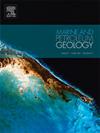Structural geometry and evolution of the eastern Yuqi strike-slip faults in the Tabei Uplift, Tarim Basin (NW China)
IF 3.6
2区 地球科学
Q1 GEOSCIENCES, MULTIDISCIPLINARY
引用次数: 0
Abstract
The strike-slip fault system in the eastern Yuqi area of the Caohu Sag, distinct from the conjugate strike-slip fault systems in the Halahatang Sag, provides a valuable case study for understanding the genetic variations among strike-slip faults across different locations within the Tabei Uplift. This system in the eastern Yuqi area comprises ENE-, NE-, N–S-, and E–W-oriented strike-slip faults. The development of the ENE- and NE-oriented faults was primarily influenced by the paleostructure, specifically the structural slope-break zone. The evolution of these fault sets can be divided into three main stages: (1) In the Late Ordovician, initial uplift occurred in the Akekule Uplift and the northern Caohu Sag, leading to the development of the western Akekule Uplift as a paleostructural high. Conjugate faults formed in the western Akekule Uplift, constrained by the rigid Yakela Fault-convex. (2) During the Silurian to Early Devonian, northward compression and subsequent extrusion along the Akekumu Fault resulted in the formation of a series of ENE- and NE-oriented sinistral strike-slip faults in the western Yuqi area, at the leading edge of the Akekumu Fault. Simultaneously, the structural slope-break zone began to develop in the eastern Yuqi area, controlling the formation and orientation of the NE- and ENE-oriented faults. (3) In the Permian, increased N–S-trending regional compression, driven by the closure of the South Tianshan Ocean, led to the formation of the reverse fault RF-ENE1 and an upward-steepening interlayer reverse fault (RF-CAO2). NE-oriented strike-slip faults, such as Fault YQ13, were reactivated, and NS-oriented strike-slip faults, including Fault YQD and Fault Lungudong, potentially experienced sinistral strike-slip movement.
塔里木盆地塔北隆起玉起东走滑断裂构造几何与演化
曹湖凹陷玉起东部走滑断裂系统与哈拉哈塘凹陷的共轭走滑断裂系统不同,为了解塔北隆起不同部位走滑断裂的成因差异提供了有价值的研究实例。该系统在豫西地区东部由NE向、NE向、N-S向和e- w向走滑断裂组成。东东向和北东向断裂的发育主要受古构造,特别是构造坡折带的影响。这些断集的演化可划分为三个主要阶段:(1)晚奥陶世,阿克库勒隆起和草湖凹陷北部发生了初始隆升,导致阿克库勒隆起西部发育为古构造高地。共轭断裂形成于阿克库勒隆起西部,受刚性亚克拉断凸约束。(2)志留纪至早泥盆世,沿阿克库木断裂向北挤压挤压,在阿克库木断裂前缘的豫西地区形成了一系列东、北东向左旋走滑断裂。同时,豫西地区东部开始发育构造坡折带,控制了北东向和东东向断裂的形成和走向。(3)二叠纪在南天山洋闭合的作用下,南北向区域挤压增强,形成逆断裂RF-ENE1和上陡坡的层间逆断裂RF-CAO2。东向走滑断裂(如YQ13断裂)恢复活动,东向走滑断裂(如YQD断裂和龙鼓洞断裂)可能发生左旋走滑运动。
本文章由计算机程序翻译,如有差异,请以英文原文为准。
求助全文
约1分钟内获得全文
求助全文
来源期刊

Marine and Petroleum Geology
地学-地球科学综合
CiteScore
8.80
自引率
14.30%
发文量
475
审稿时长
63 days
期刊介绍:
Marine and Petroleum Geology is the pre-eminent international forum for the exchange of multidisciplinary concepts, interpretations and techniques for all concerned with marine and petroleum geology in industry, government and academia. Rapid bimonthly publication allows early communications of papers or short communications to the geoscience community.
Marine and Petroleum Geology is essential reading for geologists, geophysicists and explorationists in industry, government and academia working in the following areas: marine geology; basin analysis and evaluation; organic geochemistry; reserve/resource estimation; seismic stratigraphy; thermal models of basic evolution; sedimentary geology; continental margins; geophysical interpretation; structural geology/tectonics; formation evaluation techniques; well logging.
 求助内容:
求助内容: 应助结果提醒方式:
应助结果提醒方式:


